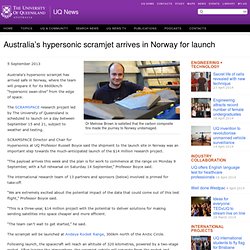

Graphene is key to fast light-to-current converter. 17 September 2013 Scientists at the Vienna University of Technology have combined a graphene photodetector with a standard silicon chip that can transform light into electrical signals, a development that could lead to improved telecommunications.

The research began two years ago when Thomas Müller and colleagues from the Institute of Photonics at Vienna University of Technology demonstrated that graphene is suited to turn light into electrical current. ‘There are many materials that can transform light into electrical signals, but graphene allows for a particularly fast conversion’, Müller said in a statement. SpaceShipTwo sets new altitude, speed record. Virgin Galactic’s SpaceShipTwo (SS2) broke its own speed and altitude records on Thursday as it successfully completed its second rocket-powered, supersonic flight.

At 8:00 AM PDT, SS2 took off slung beneath the WhiteKnightTwo (WK2) carrier aircraft from Virgin Galactic’s Mojave Air and Space Port in Mojave, California. According to the company, the tourism spacecraft went through its full technical mission profile in a single flight for the first time, including the deployment of its “feathering” re-entry mechanism at high altitude. View all SS2 was released from the carrier at 46,000 ft (14,000 m) and the rocket motor burned for 20 seconds, pushing the spacecraft to an altitude of 69,000 ft (21,000 m) and a maximum speed of Mach 1.43 (946 knots, 1,088 mph, 1,752 km/h). After engine shutdown, the pilot deployed the feathering system, where the tail section is rotated to vertical and the ship’s descent is slowed using the same principle as a shuttle cock. Source: Virgin Galactic. How do you put a big antenna on a tiny satellite? Make it inflatable.
CubeSats are certainly in the process of revolutionizing the satellite industry.

They can serve many of the same functions as full-sized satellites, but at a size of 10 x 10 x 10 cm (3.9 x 3.9 x 3.9 in) and a mass of under 1.33 kg (2.9 lb), they’re much cheaper to build and get into orbit. With that smaller overall size, however, comes smaller onboard antennas. These severely limit CubeSats’ communications range, restricting them to fairly low orbits. That may be about to change, though, as MIT is developing larger, inflatable antennas. Inflatable satellite antennas have been developed and tested before, although they were designed for regular-sized satellites, and utilized compressed air systems.
Instead, the MIT team turned to benzoic acid. Australia’s hypersonic scramjet arrives in Norway for launch. Australia’s hypersonic scramjet has arrived safe in Norway, where the team will prepare it for its 8600km/h “hypersonic swan-dive” from the edge of space.

The SCRAMSPACE research project led by The University of Queensland is scheduled to launch on a day between September 15 and 21, subject to weather and testing. SCRAMSPACE Director and Chair for Hypersonics at UQ Professor Russell Boyce said the shipment to the launch site in Norway was an important step towards the much-anticipated launch of the $14 million research project. “The payload arrives this week and the plan is for work to commence at the range on Monday 9 September, with a full rehearsal on Saturday 14 September,” Professor Boyce said. The international research team of 13 partners and sponsors (below) involved is primed for take-off. “We are extremely excited about the potential impact of the data that could come out of this test flight,” Professor Boyce said. Scramspace scramjet arrives in Norway for test flight. A revolutionary jet engine capable of operating at eight times the speed of sound has arrived in Norway.

Designed and built in Brisbane, Australia by the University of Queensland (UQ), the Scramspace is a hypersonic scramjet that will be fired by rocket in the Arctic Circle, where it will very briefly fly fast enough to travel from London to Australia in two hours. It’s part of a project to develop hypersonic technology that may one day be used to put payloads into orbit at a much lower cost than is possible today. View all Scramspace is three-year research project by an international research team of 13 partners and sponsors from five countries led by Scramspace Director and Chair for Hypersonics at UQ, Professor Russell Boyce. Its AUD$14 million (US$13.7 million ) “shoestring budget” is small compared to similar American hypersonic project budgets that run into the hundreds of millions, but it draws on two decades of Australian hypersonic research into new engine designs and materials. Buildex®. One of the worlds leading manufacturers and suppliers of self-drilling screws and fasteners.
Drill Size Conversion Table. All-optical transistor could be a big leap for quantum computing. Researchers at MIT, Harvard and the Vienna University of Technology have developed a proof-of-concept optical switch that can be controlled by a single photon and is the equivalent of a transistor in an electronic circuit.

The advance could improve power consumption in standard computers and have important repercussions for the development of an effective quantum computer. Chip manufacturers are constantly pushing to reduce power consumption to a minimum, but they still have to face the limitations that come with dealing with the world of electronics.